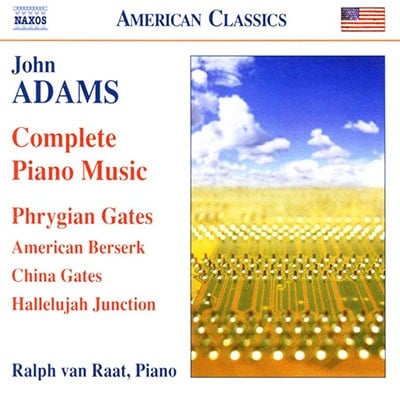Boosey & Hawkes (Hendon Music)
Hallelujah Junction is a small truck stop on Highway 49 in the High Sierras on the California-Nevada border near where I have a small cabin. For years I would pass through in my car, wondering what piece of music might have a title like “Hallelujah Junction.” It was a case of a good title needing a piece, so I obliged by composing this work for two pianos.
Two pianos is a combination that’s long intrigued me, and the pairing plays important roles in both “Common Tones in Simple Time” and “Grand Pianola Music.” What attracts me is the possibility of having similar or even identical material played at a very slight delay, thereby creating a kind of planned resonance, as if the sonorities were being processed by a delay circuit. The brilliant attacks and rich ten-fingered chords of the grand pianos suggest endless possibilities for constructing an ecstatic, clangorous continuum, the effect of which could not be achieved with any other sonorous instrument.
I begin with only the “__lle-lu-jah” of the title (a Hebrew word), a three-syllable exclamation that bounces back and forth between the two instruments until it yields to a more relaxed and regular figuration of rolling 16ths. The harmonies are essentially modal, staying exclusively in the flat regions of the circle of fifths.
Eventually the rambling, busy patter of 16ths gives way to a passage of dry, “secco” chords that punctuate the musical surface like karate chops until they too give way, this time to the serene middle movement. Here the “__lle-lu-jah” motif of the opening is gently transformed and extended above a quiet fabric of repeated triplets. These triplets become the main event as the movement tightens up and energy increases, leading into the final section. Here I take advantage of the acoustically identical sounds of the two pianos to make constant shifts of pulse (“Is it in two? Or is it in three?”). This ambiguity produces a kind of giddy uncertainty as the music pings back and forth in bright clusters.
The final moments of Hallelujah Junction revel in the full onomatopoeic possibilities of the title. We get the full four-syllables—the “Hallelujah”—as well as the “junction” of the by-now crazed pianists, both of them very likely in extremis of full-tilt boogie.
“Hallelujah Junction” was composed for my friends Grant Gershon and Gloria Cheng, who first performed it at the Gerry Center in Brentwood, California in April of 1998. It was dedicated to Ernest Fleischmann, for many years the guiding light of musical culture in Los Angeles.
“Adams has the best sense of timing of any composer today. He has an unerring instinct for when to change a harmony or texture, how long to build up to a climax, and where that climax should be placed for maximum impact. Hallelujah Junction is a compelling demonstration of that talent.” —San Diego Union Tribune

Ralph van Raat / Maarten van Veen
Naxos 8.559285

